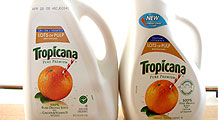The incredible shrinking cereal box
The packaging may look the same but the amount inside has gone down, that's how companies try to pass on food inflation. But consumers are wising up.
NEW YORK (CNNMoney.com) -- Consumers are starting to notice a few less snaps, crackles and pops in their Cocoa Krispies lately. That's because cereal boxes - and the amount of cereal inside - are shrinking along with most food packages in the grocery store.
As manufacturers cope with the rising cost of raw ingredients and fuel, downsizing their package sizes is one increasingly popular way to pass along a price increase without drawing too much attention.
"They're raising the prices a little, and shrinking the boxes a little," said Marcia Mogelonsky, consumer analyst with Mintel International, a consumer research firm in Chicago. "If you're running through the supermarket, you don't necessarily notice that your cereal box is an ounce or two smaller. That's how they're controlling the prices."
In June, cereal giant Kellogg (K, Fortune 500) slimmed down its cereal boxes (see photo gallery). Froot Loops, Cocoa Krispies, Corn Pops, Apple Jacks and Honey Smacks all decreased by about 2.4 ounces on average, according to Kellogg spokeswoman Susanne Norwitz.
But Kellogg isn't the only company downsizing, or charging the same price for a package that contains less food. Consumers are discovering more air in their bag of chips, fewer sheets of paper towels on the roll, thinner garbage bags and even smaller squares of toilet paper.
Unilever (UN) recently shrank bottles of Hellmann's Real Mayonnaise, Breyers Ice Cream and Skippy, among other consumer products.
"Like other companies, Unilever is working to mitigate the impact of these rising commodity costs through hedging, product reformulation and cost savings programs. We have chosen to reduce package sizes as one of our responses to these dramatic input cost increases," said Anita Larsen, a spokeswoman for the company.
But when a half gallon container of Breyer's no longer contained 64 ounces of ice cream, that's when some shoppers, like Beth Bastian, caught on.
"I noticed ice cream wasn't sold in the half gallon, although it looked like it was, and then I started to pay attention," said Bastian, mother of three. Now, Bastian said, she's aware that this is happening "across the board." But that doesn't make it any easier for her to stomach the trend toward smaller packaging.
"It almost feels insulting, like 'consumers are never going to notice,'" she said.
But consumers are noticing: 75% of those surveyed by Consumer Reports in July said they noticed packages are shrinking and 71% believed the main reason for downsizing was to hide price hikes from consumers. Yet half of those surveyed said they'd prefer that manufacturers keep the old package and raise the price.
That's not how manufacturers are seeing it. Many food companies say their customers accept, and appreciate, the choices they must make to maintain a quality product in the current economic environment.
In August, Hershey Co. (HSY, Fortune 500) announced an 11% price increase on its multi-pack and packaged candy lines because of the rising cost of cocoa, corn sweeteners, sugar and peanuts. That company didn't say, however, that some price hikes had already been implemented in May by way of smaller packaging. For example, an 8-ounce bar of Hershey's Special Dark shrank to 6.8 ounces, a reduction of 15%.
When asked about the consumer response to the downsized bar, Kirk Saville, a spokesman for The Hershey Company said in an email: "they understand the reasons behind the change."
Orange juice drinkers are also getting squeezed. According to Tropicana, a division of PepsiCo (PEP, Fortune 500), consumers welcomed the new 89-ounce bottle of Tropicana orange juice, which will replace the 96-ounce jug by the end of this year.
"Our consumer research indicates that, despite the smaller size, there was no change in the perceived value of the product because of the benefits of the added features," said Karen May, a spokeswoman from Tropicana, referring to the new bottle's snap cap.
Like it or not, there's not much consumers can do to stop the downsizing in food packaging. But awareness goes a long way, according to Edgar Dworsky, editor of mouseprint.org, a consumer education Web site that aims to expose truth in advertising.
Dworsky suggests checking and comparing the unit prices in the grocery store and opting for the brand that offers the most value.
For a less subtle approach, "complain to the company," he said. You may not save money on food, but at least you can express your distaste. ![]()




